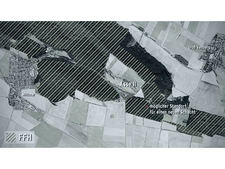Search for a site for a recovery shaft (shaft 5)
According to public procurement law, the planning for the construction of a new shaft was tendered and awarded Europe-wide at the end of 2010. Planning work will probably take several years. It will also comprise the necessary geological exploration drillings at the surface and underground.
In the context of a current-state analysis of the mining and geological conditions, several sites for a new shaft were examined at the beginning of 2011.
Factors for the selection of a site

![]() Possible site of the new shaft (click chart to enlarge)
Possible site of the new shaft (click chart to enlarge)
The site that is now being explored had been selected previously, after several factors that are decisive for successful shaft sinking had been considered and balanced. The new shaft can only be constructed at a location where there are no old cavities in the underground. It is also essential that it will not be constructed in slightly soluble potash salt. Additionally, safety distances to certain rock layers, such as the rötanhydrit at the southern flank, need to be kept, the reason for this being that no new locations will generate where saline solutions flow into the mine.
The same applies to anhydrite layers in the northern flank of the Asse mountain saddle. A sufficient safety distance also needs be kept to the existing chambers and galleries.
Verification of suitability by means of surface and underground drillings
According to the information available, only one site which is located about 500 metres to the east of the existing main shaft 2 shows the features required for a shaft site and is therefore being explored. Whether this site is actually suitable, needs to be ascertained with the help of drillings carried out underground and at the surface. Only after the exploration drillings have been evaluated can it be decided finally whether the shaft can be built at this site.

